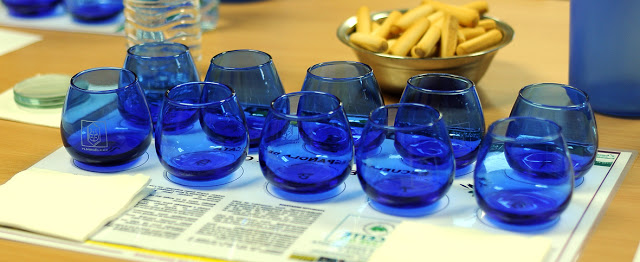Guide to DYI oil tasting
Learn to know and recognize olive oil
You do not necessarily need to be an expert to understand if an extra virgin olive oil is a good oil. By following these simple rules and repeating the tasting, you will be able to distinguish a bad oil from one with better quality. First we have to get a glass (the official one is a small blue glass) and an apple, to re-set your taste buds between one taste and another.
See
Pour two teaspoons of extra virgin olive oil into the glass, stir it and try to evaluate the fluidity by placing the oil against the light. EVO has a medium-low fluidity degree. High fluidity is typical of oils with a high content of polyunsaturated fatty acids, such as seed oil. Now turn the oil on the sides of the glass and observe the colour. A green colour is a symptom of young harvesting; yellow indicates a riper harvest of the fruit.
Smell
Bu simply smelling the oil we can understand if it is of good quality or if it is poor. The smell, anywhere near “ olive, vegetables, fruit or grass” will give us enough elements to be safe. Before this delicate olfactory phase, however, oil must be brought to the right conditions to best enhance the volatile aromatic components. To do this, heat the contents of the glass with the palm of one hand shaking slightly: the ideal temperature is equal to 28 ° C (82 F); then cover the top of the glass with the other palm of your hand in order to keep the aromas; then uncover the glass, bring it to the nose and inhale slowly and deeply to identify the olfactory components of the oil.
We suggest that you repeat this routine several times, as it will allow you to grasp the various nuances of aromas present and to feel the degree of intensity in a scale of values that can go from “barely perceptible” to “very intense”.
Once the perfume of the oil has been tested, it will not be difficult to use terms such as “green olive fruit” if the scent recalls that of fresh fruit and “ripe fruit” if it reminds you of the smell of sweet fruit. In this way it is possible to identify the degree of ripeness of the olives .
Taste (finally!)
Tasting will allow you identify some basic flavors: bitter, sweet, sour and salty.
During the tasting it is important to collect air with short and successive aspirations, tongue against the palate and semi-open lips, savor the oil for at least 20-30 seconds. In this way the olfactory perceptions are defined and the gustative, bitter, spicy, dry-astringent ones are evaluated. It is essential to remember and carefully evaluate the retro-olfactory sensations. We recommend for those who are beginners to be in no hurry to expel the oil; take your time, try to memorize the most feelings, perhaps taking written note of your perceptions.
The technical tasting must be follow some general rules:
1) Do not smoke at least 30 minutes before tasting
2) Do not use any perfume, soap or cosmetics whose smell persists at the time of the test
3) Do not swallow any food, at least one hour before tasting
4) Make sure that your physiological and psychological conditions are positive, so as not to compromise the analysis.
The nose is an important part of tasting: in fact, it is a known fact that a stuffy nose doenst allow us to distinguish food flavors when we eat. The sense of smell is connected in a functional way with taste, through chemoreceptors (the perceptions of volatile chemical substances This is why it is important to know that the taste takes shape precisely from the combination of these olfactory and gustatory sensations.
By putting together all the sensations perceived up to here, you can try to express an opinion that in the first sessions may seem unreliable. If you have performed a correct taste, you will be able to distinguish all the smells and flavors that we have memorized. If you can tell them apart from each other, then you have a good extra virgin olive oil, if these smells and flavors are also balanced, then you can say you have tasted an excellent extra virgin olive oil.
At the end of each tasting, it is useful to rinse your mouth with a slice of apple before you taste another sample of extra virgin olive oil,. All these steps may seem difficult to apply and understand but in reality it is not at all so. With a bit of practice and perhaps even with the possibility of a comparison with experienced tasters, it is possible to acquire some personal competence that will allow you to correctly evaluate an extra virgin olive oil.
Q: “I am sensing a bitter-spicy aftertaste in the throat: is that a quality or a defect?
The bitter-spicy aftertaste of an extra virgin olive oil is a quality that takes on an important value due to the high content of polyphenols (antioxidants).
The characteristic bitterish-spicy aftertaste is considered a positive attribute by the professional tasters, so do not worry if the oil is slightly bitter and spicy, it will soon become an attribute that you will hardly do without.
Always remember that the free acidity of the oil is not perceptible to the taste, since the free fatty acids of the oil are odorless and tasteless.


